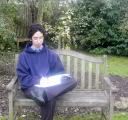Graduate 194: Advent & Ephesians, Day 21
Yesterday we focused on the resurrection of Jesus Christ as a manifestation and expression of God's power, which has also been made available to everyone who has been adopted into God's family. Paul is praying that the Ephesian Christians would come to understand (1) the hope of God's calling, (2) the riches of the glory of Christ's inheritance, given to the saints, and (3) the greatness of the Holy Spirit's power exercised on their behalf. These are all in accordance with the strength of God's might that was exercised when He raised Christ from the dead and seated Him at the right hand of God's heavenly throne. Yesterday we looked at Christ's resurrection. Today we look at His ascension and enthronement.
For additional insight into the significance of this event, I want to look at the following passage from Hebrews 8: "Now the main point in what has been said is this: we have such a high priest, who has taken His seat at the right hand of the throne of the Majesty in the heavens, a minister in the sanctuary and in the true tabernacle, which the Lord pitched, not man." Christ's ascension and enthronement are major themes in the book of Hebrews. Especially significant is the idea that Christ has been seated at the right hand of the throne of Majesty. What is implied by this image is that Jesus has completed His work and is now at rest. The work is done. It is finished.
This may be hard for us to understand because, from our earthly, temporal perspective, the work seems to be very much ongoing. Souls still need to be saved, creation has yet to be fully redeemed and restored to its original intention. God's reign is not fully experienced--not in the way that Philippians 2 describes. Yet there is a sense in which the work has already been completed. The end has already been written. There is no doubt or question about how things will turn out.
The present situation is also brought out by the author of Hebrews in a contrast that He draws between the practices of priests in the Old Testament with the work that Christ accomplished on the cross. Every year, under the old covenant, on the day of atonement, the high priest would offer a sacrifice for the sins of the people. He would bring the blood of the sacrifice into the Holy of Holies where the Ark of the Covenant resided. That ritual had to be performed every year. The work of atonement was never completed. But the author of Hebrews emphasizes that the work of Christ is complete, so that further sacrifice is no longer required. He has fulfilled the role of priest in the most perfect and complete way.
Here, again, we see the power of God manifested. Christ accomplished what no one else could. And the power that was exerted in that mighty and final act is the same power and might that are made available to the believer. A power and might that is above every other ruler, authority, power, and dominion--in this age and in the age to come.
--
God is in this place,
And that reality, seen and understood by the grace of God in Christ Jesus through the work of the Holy Spirit, makes all the difference in the world.


0 Comments:
Post a Comment
<< Home